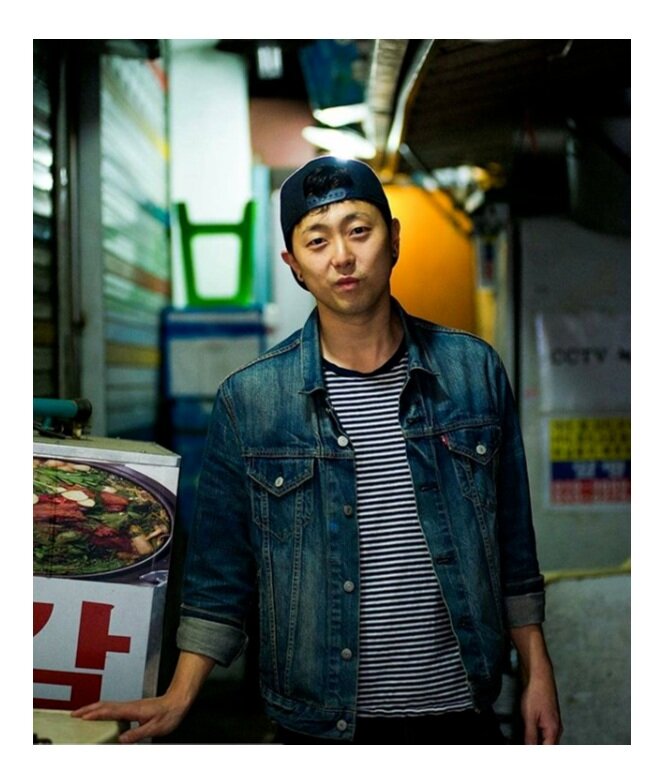On the Sunday evening of chef Greg Norrish’s dinner, people walked in to find a flickering candle and a photo album resting on a wooden table. Couples, solo diners and newly acquainted strangers touched heads like a football team before a match, huddled around a stack of white postcards.
Instead of pictures of food, dated snapshots of New England, Sacramento, New Orleans and Seoul were laid neatly for each diner to flip through.


Postcards at Greg Norrish’s pop-up dinner

Photo by Jason Kim
The theme of Norrish’s five-course dinner was “homes.” For the 33-year-old chef, who is a Korean adoptee from the United States, the tensions between ethnic identity, culture, and food lie at the center of his cuisine: in this particular dinner, each course was an homage to a city that had touched Norrish in some way, places that taught the chef that “home” didn’t have to exist within the confines of brick walls or concrete pavements.
At was four-months-old, Norrish was taken from his birth country of South Korea to suburban Connecticut with his adoptive family. The kitchen quickly became familiar turf, since his mother was a home economics teacher and sometimes went over her culinary lesson plans with him. Norrish’s gravitation towards food quickly intensified: as a high schooler, Norrish washed dishes at the back of a restaurant after school. In the following years, he waited tables, operated a retirement community kitchen, and worked in a California farm.

Baby Norrish
But even as Norrish somersaulted between coasts and kitchens, people always asked the same question.
“[Customers would] directly inquire about my ethnicity,” Norrish said. “But after some realized I was adopted, they’d sort of take a step back and ask, ‘actually, do you think you can cook Korean food? Like, do you have the right to?’”
Who has the right to cook a certain type of food? And more importantly, who gets to draw the line that demarcates what constitutes a dish as “Korean” or perhaps, “not Korean enough?”
Norrish cooked Korean food for the first time in April 2016, when he decided to throw himself into a kitchen with ingredients to make pajeon, a savory Korean pancake. He had tasted Korean food only twice in his life, both times Westernized versions more reminiscent of fast food.
“It used to make me feel sheepish to cook Korean food,” Norrish, who also goes by his Korean name Ahn Young-Keun, said. “People would point out how I didn’t grow up under Korean parents in a ‘traditional’ Korean household. But now I sort of toss the question back at them and ask, ‘what is Korean food?’ and ‘what does it mean to be Korean?’”
Norrish bounces from city to city, sometimes between countries, hosting pop-up dinners that highlight Korean flavors and he usually expects a full house. But as Korean cuisine begins to pique the interests of an increasingly mainstream audience, it, along with other immigrant or “ethnic” cuisines, is lumped into a vague sphere of otherness and thrown into the authenticity trap.
The glamorization of “authentic” food, a utopian expectation of a dish to be untouched and perfectly preserved in its original state, has infiltrated the lexicon of the everyday consumer. It’s become a key aspect that diners mentally check off before heading over to a restaurant. But the authenticity scale can quickly tip one way or another.
The glamorization of “authentic” food, a utopian expectation of a dish to be untouched and perfectly preserved in its original state, has infiltrated the lexicon of the everyday consumer.
According to a study of 20,000 Yelp reviews, users associated “authentic” non-European restaurants with, “dirt floors, plastic stools, and other patrons who are non-white”, while elegance and ambiance determined the authenticity of European establishments.
Krishnendu Ray, who serves as the chair of the food studies program at New York University and is also the author of The Ethnic Restaurateur calls it the internal hierarchy of tastes.
“Sometimes, our judgments of good taste has nothing to do with literal taste,” Ray told NPR. “It has to do with our notions and conceptions of a class of people.” In other words, power.
Questioning Norrish’s “right” to cook as an adoptee and his access to Koreanness in a culinary world where power has historically been— and still is— unevenly distributed parallels the faulty logic behind “reverse racism” which, “ignore[s] the fundamental question of who holds more power/privilege” while assuming that, “racism occurs on a so-called level playing field.” The critics fail to take into account the fact that Norrish was denied access to his Koreanness and his desire to reclaim his heritage is vastly different from someone with no historical ties to a country attempting to replicate a cuisine for profit.
Adoptions became a lucrative industry as a means for the Korean government to pay back loans after the post-war economic recession. According to the Institute for Policy Studies, adoptions from South Korea generated roughly $35 million annually in 2011, with a single overseas adoption amounting to about $15,000. Simultaneously, Western countries began to craft their own narratives about the origins of Korean overseas adoption, one that involved portraying the country as one filled with, “thousands of needy children” requiring “a quintessential American frontier figure, and a Christian God,” according to Eleana J. Kim, author of Adopted Territory.
Adoptions became a lucrative industry as a means for the Korean government to pay back loans after the post-war economic recession.
As an adoptee, Norrish said that the authenticity bar is set especially high for him in Korea, a country where family lineage is closely tied to prestige. When cooking in more casual settings, people would deem certain ingredients Norrish used in the States such as black sesame, lotus root, and sesame leaf “too mundane.” The constant pressure to over-perform and “hyper-Koreanize” a dish in order to compensate for his upbringing weighed heavily on Norrish’s shoulders.
The only space where there was actually an elevated expectation regarding his culinary techniques was in the fine-dining world — a growing sphere but one anchored by Eurocentric standards.

Greg Norrish working his magic
Chef Matt Blesse, who works at Magpie Brewery and is also a Korean-American adoptee, acknowledged that Korean cuisine, both domestically and abroad, is still boxed under a glass ceiling that operates on a double standard.
“It’s ironic that Korea’s most celebrated chefs, especially in the world of fine dining, have all received their culinary training abroad,” Blesse said, listing restaurants like Jungsik and Soignè. (The head chefs of both studied in New York City).
“Korea is all about authenticity and gatekeeping of who belongs to Koreanness,” he said. “But at the same time, the chefs and food they celebrate aren’t purely Korean, but rather a product of a globalized world.”
Perhaps the food that both Chefs Norrish and Blesse are creating ultimately cannot be categorized under any cuisine. Maybe it’s something more powerful. Blesse said that he doesn’t really have an interest in cooking Korean food and that he views his food as “adoptee food”: dishes informed by his lived experiences in the liminal space that adoptees occupy culturally and politically. Norrish thinks that the binary concept of “fusion food” will dissipate as more people from marginalized backgrounds find platforms to share their stories and redefine food narratives.
Blesse said that he doesn’t really have an interest in cooking Korean food, and that he views his food as “adoptee food”: dishes informed by his lived experiences in the liminal space that adoptees occupy culturally and politically.
“Identity is multifaceted,” Norrish said. “There are Korean-American adoptees around the world like me, but the diaspora is so much vaster. The idea of fusion food seems too compartmentalized to me, like taking X and combining it with Y.”

Chef Norrish’s shrimp étouffé. Photo by Jason Kim
During his pop-up dinner, Norrish mostly remained tucked away in the back of the kitchen, chopping chives and meticulously plating dishes. Customers saw only glimpses of the chef, clad in a stained, white undershirt and grey apron. Only for a brief moment did he step outside to bashfully thank everyone for coming.
Norrish didn’t need to do much talking, though: the flavors buried inside of the food spoke for themselves.
Faint hints of bang ah, a Korean herb, lingered in the oil used to make the New England clam chowder appetizer, a tribute to Greg’s naiveté and memories of growing up in Connecticut. Instead of clams, dense chunks of jeonbok, a briny shellfish harvested on Jeju Island, were submerged in the depths of the creamy soup.
Creole flavors that spoke of Greg’s time running a volunteer kitchen in New Orleans could be found in the shrimp étouffé, which subtly contrasted with the sweet, pickled aroma of gwaree gochu, a Shishito pepper, as well as the chewy texture of Korean waxy corn kernels.
“My reference points in memory and taste started to converse with each other as I became more comfortable piecing together my own story,” Norrish said. “As I tasted new foods, I asked myself, what does this remind me of and what flavors that are personal to me not only pair well with this dish but also make space for a deeper and more complex narrative?”
Perhaps instead of asking ‘what is your favorite cuisine?’, an interesting alternative might be, ‘where have your taste buds walked?’ The flavors that enter our mouths and are archived in our memories are like the footsteps we take when traveling. Oftentimes, our palates can find home, an ambivalent but strong sense of belonging, in ways that surpass mere physicality, like in the people we break bread with or the erupting laughter at that one dinner that still rings in the distance.
“You know, I could have easily chosen to go down the culinary route without having my Korean identity be a part of me,” Norrish said. “But I needed it to be a part of me.”
Cover Photo by Shane Bolen






